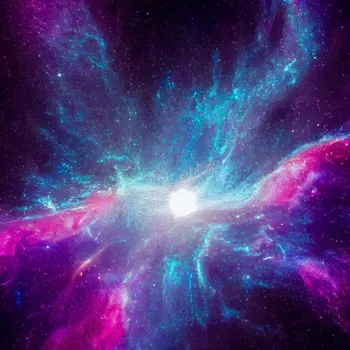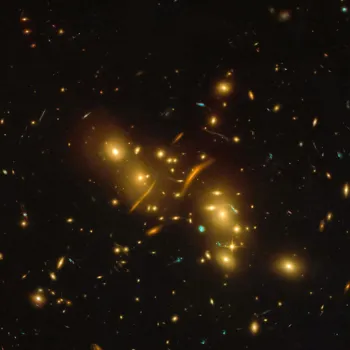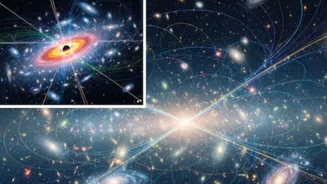Unveiling Cosmic Microwave Background: Key to Universe's Origin. Dive into this cosmic journey to unravel 10 mind-blowing facts!
Namaste readers! Ever wondered about the echoes of the Big Bang? Well, today
we're diving into something truly fascinating – the Cosmic Microwave Background radiation, or CMB for short. It’s like peering back in time to the universe's infancy!
This faint glow, permeating the cosmos, holds clues to the origin and evolution of everything around us. So, grab your chai and let's explore 10 amazing facts about this cosmic afterglow that every Indian should know.
The CMB is the Afterglow of the Big Bang
Imagine the Big Bang as the ultimate Diwali cracker – a massive explosion that birthed the universe. About 380,000 years after this colossal event, the universe cooled down enough for electrons and protons to combine and form neutral hydrogen atoms.

This allowed light to travel freely for the first time. The CMB is essentially this first light, stretched and cooled over billions of years as the universe expanded. It's like a faint echo of that initial explosion, detectable across the entire sky!
Think of it as the universe's baby picture, revealing its earliest moments.
It's Incredibly Uniform, But Not Perfectly So
At first glance, the CMB appears remarkably uniform across the sky. This uniform temperature tells us that the early universe was incredibly smooth and homogeneous. However, scientists have discovered tiny temperature fluctuations in the CMB, variations of only a few parts in a million.
These seemingly insignificant differences are enormously important! They represent the seeds of all the structures we see today – galaxies, clusters of galaxies, and even us!
These subtle variations led to areas of slightly higher density, which, over time, attracted more matter through gravity, eventually forming the cosmic structures we observe.
It Confirms the Big Bang Theory
The existence of the CMB is one of the strongest pieces of evidence supporting the Big Bang theory. The Big Bang model predicted that the early universe would have been extremely hot and dense, and that as it expanded and cooled, this heat would have lingered as a faint afterglow.
The discovery of the CMB in 1964 by Arno Penzias and Robert Wilson provided direct observational evidence for this prediction, solidifying the Big Bang theory as the leading model for the origin and evolution of the universe.
Without the CMB, the Big Bang theory would be missing a crucial foundation.
It's Everywhere You Look
The CMB isn't localized to a specific region of space; it permeates the entire universe. No matter where you point your telescope, you'll detect this faint signal.
The existence and ubiquity of the CMB mean that this radiation field represents a fundamental property of the universe, and its study gives scientists constraints on when was the Big Bang event.
As a result, the CMB is like background static that the is present everywhere in the cosmos and is a remnant from the Big Bang event.
It's a Cosmic Thermometer
The average temperature of the CMB is incredibly cold – about 2.725 Kelvin, which is roughly -270.425 degrees Celsius or -454.765 degrees Fahrenheit. This extremely low temperature is a direct consequence of the universe's expansion and cooling over billions of years.
By studying the temperature variations in the CMB, scientists can learn about the density and composition of the early universe, as well as the rate at which it has been expanding since the Big Bang. It is a tool used by the cosmos to perform many thermal based experiments.
The CMB plays a crucial role in understanding the evolution of cosmic structures, providing insights into the distribution of galaxies and the large-scale structure of the universe. These areas with higher matter density, which are observed as temperature variations in the CMB, are crucial for the formation of galaxies.
The discovery of the CMB confirmed a crucial prediction and set the stage for further explorations into the universe's past. Observing the CMB also provides clues about the universe's age, composition, and expansion rate.
It Helps Us Understand the Universe's Age and Composition
By studying the CMB, scientists have been able to determine the age of the universe with remarkable precision. Current estimates based on CMB observations place the age of the universe at approximately 13.8 billion years.
Additionally, the CMB provides valuable information about the composition of the universe, revealing that it consists of about 5% ordinary matter (the stuff we see around us), 27% dark matter (an invisible substance that interacts gravitationally), and 68% dark energy (a mysterious force driving the accelerated expansion of the universe).
Understanding these proportions is one of the biggest achievements of modern cosmology.
Satellites Like Planck and WMAP Have Mapped It
Over the years, several space missions have been dedicated to mapping the CMB with increasing precision. NASA's Cosmic Background Explorer (COBE) was the first to detect the CMB's temperature fluctuations in the early 1990s.
Subsequent missions, such as WMAP (Wilkinson Microwave Anisotropy Probe) and Planck, have provided even more detailed maps, revealing the subtle temperature variations with unprecedented accuracy.
These maps have revolutionized our understanding of the early universe and have provided crucial data for testing cosmological models. The accuracy of these missions has been improved with better sensor.
It's a Window into Inflation
Inflation is the theory that, immediately on the back of the Big Bang event, the new Universe underwent a rapid exponential burst in its size, and the properties of the CMB provide strong insights to it.
Inflationary models predict specific patterns in the CMB's polarization, which scientists are actively searching for. The detection of these patterns would provide strong evidence for inflation and shed light on the fundamental physics that governed the universe in its earliest moments.
Discovering inflation is important as it would help understand more about the early stage and expansion of the universe.
It's Polarized Like Light
Just like light, the CMB is polarized, meaning that its electromagnetic waves oscillate in a preferred direction. This polarization pattern contains information about the conditions in the early universe, including the presence of gravitational waves generated during inflation.
Scientists are studying the polarization of the CMB to search for these primordial gravitational waves, which would provide further evidence for inflation and offer insights into the physics of gravity at extremely high energies.
One of the important theories is related to primordial gravitational waves and its polarization detection becomes a very important experiment.
Future Missions Will Reveal Even More
The study of the CMB is an ongoing endeavor, with future missions planned to probe it with even greater sensitivity and precision.

These missions aim to detect faint signals buried within the CMB, such as the signature of dark matter annihilation or the effects of neutrinos on the CMB's polarization.
By pushing the boundaries of our observational capabilities, future CMB experiments promise to unlock even more secrets about the origin and evolution of the universe. This allows for a clear and more insightful study in Cosmic Microwave Background.
Fascinating facts about Cosmic Microwave Background radiation
So there you have it – 10 fascinating facts about the Cosmic Microwave Background radiation. It's a testament to human curiosity and our relentless pursuit of understanding the cosmos. The CMB has been a very useful tool in expanding our knowledge of the universe and its origin.














